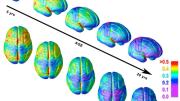“My father was a professional painter who painted everything from life,” Thomas professor of history of art and architecture Joseph L. Koerner recalls. “[U]sually out of doors and featuring persons found on the spot and involved in odd activities: people in bathing suits waiting for a train to the beach, a woman walking her pet tortoise on a leash, a midget feeding wild boar in the woods, a boy balancing a paper castle on his head.…Eventually, to have something to do, I started to paint with my father. This gave me time to wonder what bits of everyday life were the most paintable.” Such bits were the very stuff of the secular “genre painting” that arose in sixteenth- and seventeenth-century Europe—the origins of which are the subject of his Bosch and Bruegel: From Enemy Painting to Everyday Life (Princeton, $65), on which he has been engaged for some 20 years. That youthful experience of painting appears to have informed Koerner’s appreciation of these artists, as well as his own powers of observation and description, as in this passage from chapter one:
To experience Bruegel’s paintings in the original, in the midst of life, is to be jostled by a crowd. Mass audiences obscure the aura of many famous masterpieces, turning them into sideshows in the carnival of cultural display. Bruegel, by contrast, makes crowds seem a cheerful extension of his art. Not only are his paintings packed with people—with revelers, with children, with entire armies of the living and the dead—these teeming masses behave like proper crowds. Some cluster in groups that act in unison, dancing, marching, feasting, fighting, building, and playing, while others stand a bit apart and observe the goings-on passively, as would an audience. And when people in Bruegel’s paintings play the role of spectator—when they peer curiously through windows and pour through doorways to glimpse some street theater performed outside; when they stare, confused, at the fallen Saul at his moment of conversion to the Apostle Paul; when they, grown-ups and children alike, on horseback and on foot, hurry toward Golgotha to reserve a good spot to witness Christ’s Crucifixion; and, most of all, when they turn from the diversions that have captured them in the picture to gape directly out at us gaping curiously back at them—their painted world gathers us, ourselves people in a crowd, into their inner fold. In Vienna, as in the museums in Berlin, New York, Madrid, Antwerp, and Detroit where the other major Bruegels hang, one can spot this artist’s paintings from far off simply by the large and lingering audience they inevitably draw. A supreme portraitist of crowd behavior, Bruegel cleverly reflects and stage-manages his own mass appeal. This is surprising. With his printed images—published in large editions and sold on the open market—he banked on a large viewership. But with his paintings, he addressed a select few. Only the most affluent burghers of the super-rich towns of Antwerp and Brussels could commission and behold the paintings we now admire.







